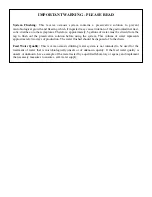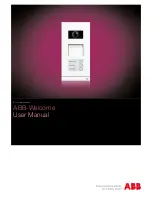
5
Installation Requirements
READ THIS ENTIRE INSTALLATION AND SERVICE GUIDE BEFORE BEGINNING INSTALLATION.
The Economy Reverse Osmosis (RO) Drinking Water Treatment Systems have been designed for ease of installation and
serviceability and are constructed with the finest materials available. Using these instructions and paying close attention
to the parameters outlined within "CONDITIONS FOR USE" detailed on Page 2 will ensure a successful installation.
To ensure a system continues to operate at its optimum level, it is necessary to have a routine maintenance and
replacement schedule (page 16). Frequency at which filters must be changed will depend on quality of feed water supply
and level of system usage.
These RO systems contain a replaceable treatment component critical to the efficiency of the system.
Replacement of the reverse osmosis component should be with one of identical specification, as defined by
WaterGroup to assure the same efficiency. Product water shall be tested periodically to verify the system is
performing properly.
DO NOT USE WITH WATER THAT IS MICROBIOLOGICALLY UNSAFE OR OF UNKNOWN QUALITY
WITHOUT ADEQUATE DISINFECTION BEFORE OR AFTER THE SYSTEM.
All State/Provincial and local government codes regarding installation of these devices must be observed.
Verify Water Supply is Potable
The water supply must meet provincial/state and/or national standards for potable drinking water. Water samples should
be sent to a certified laboratory for analysis.
Placement of Components
Placement of the various components of the system will vary from installation to installation. The main objective is to place
the components so that they are accessible for servicing and ease of installation.
Do not place module where it will be exposed to freezing and/or direct sunlight.
Spigot
Proper faucet placement should ensure a no-splash waterfall pattern into the sink. The spigot handle should be positioned
to either the left or right as one faces the sink.
Storage Tank
The storage tank should be placed so that it can be easily removed from under the sink.
Avoid placing the storage tank
in out-of-the-way cabinets or dead spaces
. There are two reasons for this: 1) the difficulty of installation increases
significantly and 2) when the storage tank is located further away from the faucet, the flow rate diminishes.
Module Assembly
The module assembly should be hung on a sink cabinet side-wall with the two wood screws.
Quick Connect Fittings
All connections are quick connect fittings except for the compression fitting at the inlet sadle valve, drain saddle valve and
storage tank shutoff valve.
Summary of Contents for E50TFC-3NSF
Page 20: ...17 ...
Page 21: ...18 Reverse Osmosis Drinking Water System Flow Diagram all models ...
Page 23: ...20 ...









































